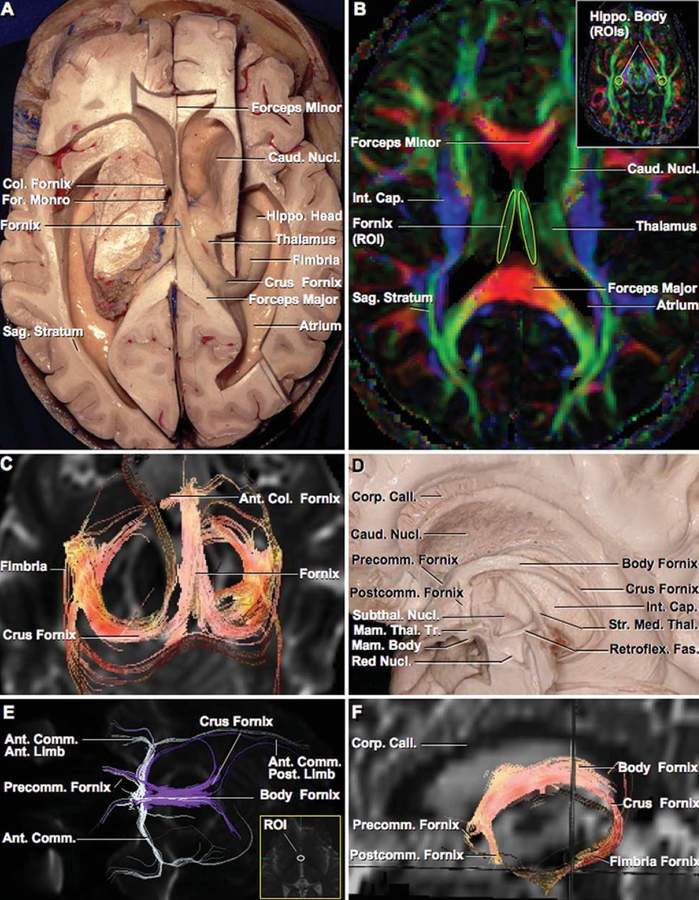Fornix
7214
Surgical Correlation
Tags
Fornix. A, Successive transverse and horizontal cuts have been made to expose the lateral ventricles. The initial part of the fornix, the fimbria, arises in the floor of the temporal horn on the ventricular surface of the hippocampal formation and passes posteriorly to become the crus of the fornix. The crus wraps around the posterior surface of the pulvinar of the thalamus and arches superomedial toward the lower surface of the splenium of the corpus callosum. At the junction of the atrium and the body of the lateral ventricle, the paired crura meet to form the body of fornix, which runs forward along the superomedial border of the thalami in the medial wall of the body of the lateral ventricle. The body forms a gentle arch located between the roof of the third ventricle and the floor of the body of each lateral ventricle. The body of fornix splits into two columns to form the anterior margin of the openings of the foramen of Monro into the lateral ventricles. B, Color-coded DTI map of an axial plane at the level of the fornix to be correlated with A. Several white matter tracts are identified by virtue of their anatomic location and color-coded orientation. The fornix is a tract with longitudinal orientation (green), which courses on the roof of the third ventricle under the body of the corpus callosum. An ROI (yellow) is selected at each fornix for tractographic reconstruction (C, E, and F). The forceps minor and major of the corpus callosum are formed by lateromedial commissural fibers (red), the sagittal stratum have a partially oblique but predominantly anteroposterior orientation (green), and the internal capsule at his level has a predominant vertical orientation (blue). The inset shows a color-coded DTI axial map at the level of the cerebral peduncles used for the selection of additional ROIs (yellow) to complete the reconstruction of the fornix; the fimbria is identified as an anteroposterior tract (green) situated lateral to the posterior third of the cerebral peduncle (yellow circles). C, Bilateral tractographic reconstruction of the fornix, axial view. The fornices travel from the hippocampal formation to the mammillary bodies and septal region and form the so-called internal limbic circuit. D, The thalamus, which faces the medial surface of the posterior limb of the internal capsule, has been removed. Two white matter bundles cross the superior surface of the thalamus: the stria medullaris thalami, which runs from the habenular region to the septohypothalamic region, and the fornix with its different portions. The column of the fornix splits in a postcommissural portion, directed toward the mammillary body, and a precommissural portion, which ends in the septal region. The mammillothalamic tract, which interconnects the mammillary bodies with the anterior nucleus of the thalamus, has been divided above the mammillary body and removed. The subthalamic nucleus of Luys is exposed below the thalamus, at the lower margin of the internal capsule. The red nucleus is located in the mesencephalic tegmentum. The fasciculus retroflexus or habenula–interpeduncular tract runs from the habenular ganglium to the interpeduncular nucleus. E, Simultaneous tractographic reconstruction of the fornix and anterior commissure. Precommissural and postcommissural forniceal fibers (magenta) pass around the anterior commissure (white), which bifurcates in an anterior and posterior limb. The inset shows the location of the ROI (white) used for the reconstruction of the anterior commissure. F, Sagittal view of tractographic reconstruction of the fornix (to be correlated with D) showing the fimbria, crus, body of fornix, and bifurcation of the anterior column in pre- and postcommissural fibers. (Images courtesy of E de Oliveira)




